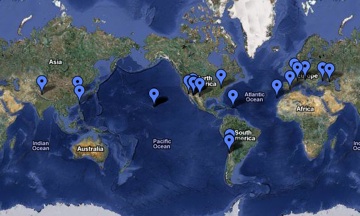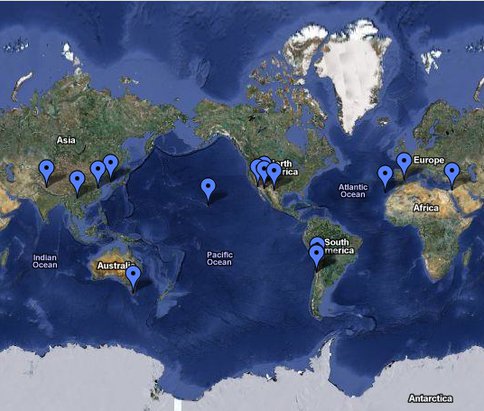2010 Annual Science Report
 University of Hawaii, Manoa
Reporting | SEP 2009 – AUG 2010
University of Hawaii, Manoa
Reporting | SEP 2009 – AUG 2010
Stardust NExT and EPOXI Mission Observing Coordination
Project Summary
We have been supporting small body (comet) space missions both with ground based observations and by coordinating a world-wide observing effort.
Project Progress
Space Mission Support Campaigns
StardustNExT: Many of the postdoctoral fellows obtained astronomical observations of comet 9P/Tempel 1, the target of the StardustNExT mission (encounter 2/14/2011). An intensive world-wide observing campaign was coordinated by K. Meech utilizing 450 whole or partial nights at 14 observatories to get time resolve photometry of the comet to refine our understanding of the rotation period. After the Deep Impact encounter with this comet it was noted that not only was the rotation period changing, but the rate of change was slowing. Because of limited spacecraft fuel, we had to make use of gravitational energy from the Feb. 2010 earth close approach as our last chance to make a time of arrival adjustment so that we would be able to see the impact crater made by the Deep Impact space craft during the StardustNExT encounter. In an unprecedented international effort enough data was obtained, up through Christmas 2009 to enable predictions to be made for a time of arrival adjustment.
EPOXI: As the Deep Impact mission before, this mission requested a suite of earth-based and earth-orbital observations to cover timescales and types of experiments inaccessible to space to complement encounter date, and to provide key mission information about the spin period of the target comet nucleus, 103P/Hartley 2 (Hartley 2), shape, to assess the dust hazard and through measurements of the position get final information for navigation. Team member Karen Meech engaged the network of observers who had supported the Deep Impact and StardustNExT missions, and developed a website for collaboration as things lead up to the encounter on Nov. 4, 2010. The observations started during mid spring 2010 after the comet came out from behind the sun, and in total more than 500 whole or partial nights world wide involving 10 countries (Chile, China, France, India, Italy, Russia, Spain, Taiwan, Ukraine, USA), space facilities and more than 50 telescopes are planned.
UHNAI team members led a ground-based telescope observing campaign to obtain simultaneous sensitive high-resolution infrared and optical observations of Hartley 2. Our key objectives were to monitor the organic volatile species and D/H and in particular to was to take advantage of a unique close Earth approach (Δ = 0.1208 AU on UT Oct. 20 2010) to conduct the most sensitive measurements of cometary deuterated water and key parent volatiles. At close earth approach the Doppler shift was 0 km/s thereby providing the highest sensitivity for measuring the deuterium-to-hydrogen (D/H) ratio in water. The EPOXI spacecraft did not have the capability to make these measurements in-situ. In addition, our investigation of the comet’s overall native volatile composition will provide the key data needed to interpret low-resolution spectra acquired by the spacecraft, which had insufficient resolution to distinguish individual parent volatiles. As was shown for comet 9P/Tempel 1 during the Deep Impact encounter, high-resolution infrared spectroscopy is critical in interpreting possible detections of the organic features and H2O, CO, and CO2 from the spacecraft.
Studies of comets at both optical and IR wavelengths provide significant clues regarding their chemical origins and early history. High-resolution optical spectroscopy is an efficient and sensitive means of detecting the building blocks of cometary ices (e.g. O, CN, CH, C2, C3, and NH2) in the coma. Measurements of brightness and radial distribution provide information on daughter molecule production rates, the species-specific outflow velocities, and the photochemical scale lengths of their parents. In addition, abundance ratios of isotopes (notably 15N/14N in NH2) provide key observations for understanding material originally formed in dense interstellar clouds. Enhancements in 15N suggest a presolar origin and obtaining the value of the N isotope in a Jupiter family comet is of importance in view of their different place of birth. Although less sensitive than optical spectroscopy, high-resolution IR spectroscopy can efficiently detect many of the potential parent species (e.g. H2O, HCN, CH3OH, H2CO, C2H6, C2H2, and NH3). Comparison of production rates, isotopic ratios, and spatial distributions for multiple species at optical and IR wavelengths will thus provide detailed information on the chemistry of Hartley 2 and critical insight into the parentage of daughter and granddaughter species. Furthermore, the proposed study has impact beyond this comet as lessons learned can be applied to understanding the parentage of daughter species within a large existing optical and infrared database, leading to new insights into the formation environment and evolutionary processing history of the solar system.

World map showing the location of all the observers for the EPOXI mission campaign.
World map showing the location of all the observers for the StardustNExT mission campaign.
-
PROJECT INVESTIGATORS:
-
PROJECT MEMBERS:
Jacqueline Keane
Co-Investigator
Michael Mumma
Co-Investigator
Jana Pittichova
Co-Investigator
Timm Riesen
Co-Investigator
Hermann Boehnhardt
Collaborator
Steve Chesley
Collaborator
Olivier Hainaut
Collaborator
Heather Kaluna
Graduate Student
Sarah Sonnett
Graduate Student
Anthony Zenn
Graduate Student
-
RELATED OBJECTIVES:
Objective 2.2
Outer Solar System exploration

